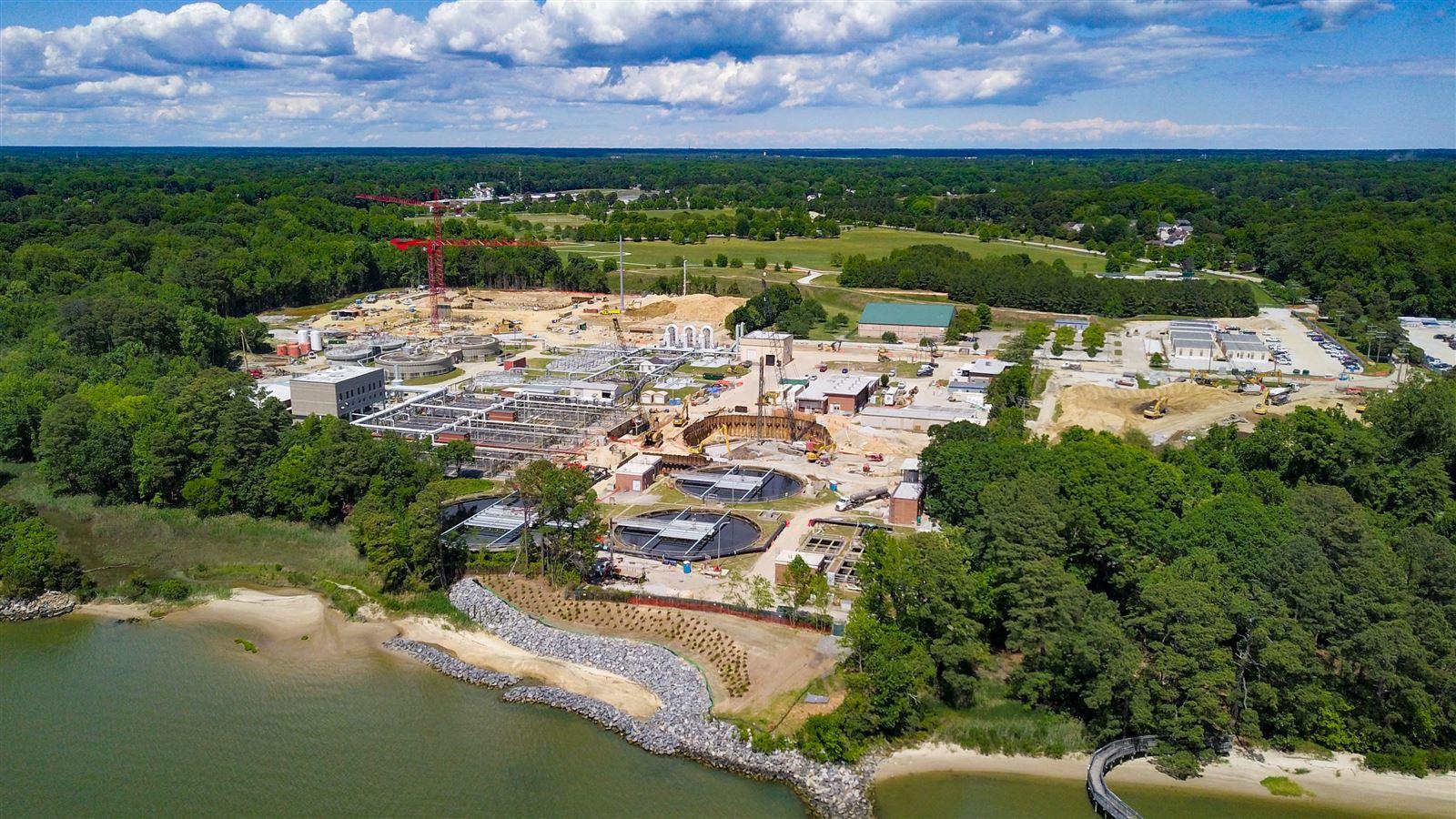Making Climate Science Actionable: Monetizing Risk and Resilience for HRSD
The Hampton Roads region is a diverse, thriving, and economically stable area, home to major Navy, Air Force, Army, Marine Corps and Coast Guard facilities. Many historical sites and attractions make the location an enticing place to live and work, visit or put roots down.
But the area is no stranger to the impacts of the changing climate. Hampton Roads is one of the most vulnerable regions in the United States to the impacts of flooding, and this is projected to increase in severity for decades to come. The combination of land subsidence and rising ocean levels increases the risk of higher tides and higher storm surges. Heavy rainfall events are also projected to increase in their intensity and frequency, which could result in localized flooding as streams overflow and add more stress to existing stormwater systems.
HRSD, the regional wastewater authority, serves the area with one mission—to protect public health and the waters of Hampton Roads by treating wastewater effectively. HRSD provides the regional backbone for the locality sanitary sewer systems that serve nearly 2 million people in 20 cities and counties. HRSD itself operates more than 500 miles of pipe and over 150 aboveground facilities. These engineered facilities have somewhat sensitive structural, mechanical, and electrical elements and are essential for the proper function of the regional sanitary sewer system that relies on HRSD’s pumping stations and treatment plants to convey and treat the wastewater generated by the Hampton Roads residents, businesses, industrial sites and military installations. The low topography of the region and its climatology and proximity to the coast make it susceptible to flooding. This makes HRSD’s infrastructure susceptible to flooding now and in the future.
Though HRSD has a wet weather management plan that ensures the conveyance capacity of the sanitary sewer system and an active hurricane preparedness plan that allows for HRSD to effectively respond to major storms, the catalyst for this project was the staggering rainfall the area endured post-Hurricane Matthew in 2016. The area received 12 inches of rain in two weeks leading up to the hurricane. When the remnants of Matthew arrived, the Hampton Roads area experienced another 12 inches of rain—this time, in less than 12 hours. There was nowhere for the water to go, which presented new challenges for the region. To boost resilience and fortify its abilities to convey and treat wastewater, protect public health and preserve the environment, HRSD teamed up with CDM Smith to make climate science actionable by establishing flooding exposure from existing conditions, analyzing climate change impacts, and preparing for the future.
HRSD's Climate change planning study
The overarching goals of HRSD’s Climate Change Planning Study were to:
- Analyze the impacts of flooding associated with climate change on HRSD wastewater infrastructure, with a focus specifically on treatment plants and pumping stations that are aboveground facilities
- Identify capital improvement program projects to prepare HRSD for climate resilience
The study's core is a risk assessment that estimates current flood exposure on specific facilities and the increase in flood exposure as climate change occurs over time. The study frames flood risk from an economic perspective, which allows HRSD to compare the cost to implement resilient flood mitigation concepts for each facility.
flood exposure and risk of hrsd's facilities
The first step in a risk assessment is a screening process that identifies the number of locations to assess. HRSD is responsible for over 150 aboveground facilities that collect, convey, and treat wastewater, most of which are critical to maintaining HRSD’s mission. The team included 136 facilities in the flood exposure evaluation. The remaining facilities were exempt because they did not have critical equipment, or they were designated to be replaced, relocated, or otherwise further evaluated by HRSD.
The second step is understanding the exposure of each facility to current and future flooding. This step “screens out” facilities that are unlikely to be impacted by flooding and identifies a list of vulnerable facilities for more evaluation.
The study considered three sources that cause flood waters in the region: storm surge, riverine and rainfall runoff. It assessed current and future conditions through 2100, including if more than one of these events happened simultaneously. The future conditions include changes to intensity and frequency based on Global Climate Models (CMIP5) and sea level rise estimates from the National Oceanic and Atmospheric Administration and the USACE North Atlantic Coast Comprehensive Study.
The team evaluated the potential magnitude of flood water levels using hydrologic and hydraulic (H&H) analyses to understand storm surge, riverine, or rainfall runoff for 2020 and three future conditions for 10% (10-year storm), 4% (25-year storm), 2% (50-year storm), 1% (100-year storm), and 0.2% (500-year storm) annual chance events at HRSD sites chosen for further evaluation. These conditions are called “planning horizons,” and they considered the modeled flooding conditions by 2050, 2080, and 2100.
The third step compared exposure of the 136 facilities to the anticipated flood water levels at the respective site. Flood pathways (locations where water can enter a building) for each facility were compared to the flood water level predicted at that facility for a 1% annual chance event in 2100. Many HRSD facilities weren’t included in further analysis because the flood water level is not expected to be above a flood pathway that could cause damage. This left 72 facilities identified as “at-risk.”
For the “at-risk” facilities, the team quantified flood risk in terms of a dollar value, considering the consequences and likelihood of flooding at a facility. The technique used was based on proven benefit-cost methodology accepted by the Federal Emergency Management Agency (FEMA) and built into the dynamic, state-of-the-art process developed by CDM Smith. One of the differentiating benefits of this process is the ability to evaluate the risk based on the chances of water reaching critical elevations at a facility and how risk is expected to increase over time with climate change. Unlike traditional methods, the analysis was not limited to a specific type of event (i.e. the 1% chance annual event). This provides a better understanding of cumulative risk which enhances resilient decision-making and allows for HRSD to prepare for all kinds of events—from small events to big storms—instead of only preparing for damages from a single type of storm.
The final step was to understand the cost implications for resilient solutions to inform HRSD’s capital improvement planning process. After evaluating the flood risk for each facility of interest, the team decided how flooding could be mitigated through resilient actions and infrastructure. Dry floodproofing, floodwalls, levees, and elevating/relocating a facility are some examples of concepts identified as best suited for HRSD. But there are many flood mitigation options that include larger watershed solutions that can reduce flood risk for a whole community, like planning, conservation, zoning changes, and floodplain management plans. Sometimes, the best option may be no mitigation at all—and HRSD would accept the risk. The team then evaluated how much the identified resilient actions could reduce flood risk for 57 of the 72 at-risk facilities, and if the cost was worth the benefit. Comparing pre- and post-mitigation risk helps HRSD understand how much risk would remain—because it cannot be eliminated entirely—and plan accordingly.
The team used multi-objective optimization to efficiently and effectively determine a capital investment schedule that maximized total benefits, minimized annual cost variance and minimized the maximum annual project count. This innovative optimization allowed evaluation of over 1,000,000 possible capital improvement schedules. This gave HRSD the confidence that the proposed schedule was optimal for HRSD to manage risk.
HRSD's path forward
Equipped with actionable climate science, HRSD has identified solutions to protect its facilities over the next 80 years to address the complex, multimillion dollar risk posed by current and future flood exposure. HRSD will implement flood resilience projects as necessary to protect its at-risk facilities and will take future flood levels into consideration for new facilities.
This project allows HRSD to save and invest for the future with the confidence to make risk-based decisions.

We delivered a leading-edge approach to flood resilience and climate change planning that is adaptable for HRSD and other utilities.














